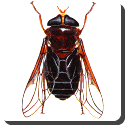 Horsefly — Insects in the order Diptera, family Tabanidae, are commonly called Horse flies. Often considered pests for the bites that many inflict, they are among the world’s largest true flies. They are also important pollinators of flowers, especially in South Africa. Tabanids occur worldwide, being absent only at extreme northern and southern latitudes. Flies of this type are among those known sometimes as “gadflies”, “zimbs” or “clegs.” In Australia, they are known as “March” flies.
Horsefly — Insects in the order Diptera, family Tabanidae, are commonly called Horse flies. Often considered pests for the bites that many inflict, they are among the world’s largest true flies. They are also important pollinators of flowers, especially in South Africa. Tabanids occur worldwide, being absent only at extreme northern and southern latitudes. Flies of this type are among those known sometimes as “gadflies”, “zimbs” or “clegs.” In Australia, they are known as “March” flies.
There are approximately 3,000 species of horse flies known worldwide, 350 of which are found in North America. At least three subfamilies are recognised:
- Chrysopsinae
- Pangoniinae
- Tabaninae
- the genus Zophina is of uncertain placement, though it has been classified among the Pangoniinae.
Two well-known types are the common horse flies, genus Tabanus Linnaeus, 1758 and the deer flies, genus Chrysops Meigen, 1802 also known as banded horse flies because of their coloring. Both these genera give their names to subfamilies. The “Blue Tail Fly” in the eponymous song was probably a tabanid common to the southeastern United States.
Adult horse flies feed on nectar and sometimes pollen. Females require a blood meal for reproduction. Males lack the necessary mouth parts (mandibles) for blood feeding. Most female horse flies feed on mammal blood, but some species are known to feed on birds, amphibians or reptiles. Immature or larval horse flies are fossorial predators of other invertebrates in moist environments.
The bite from a larger specimen can be painful, especially considering the light, agile, and airborne nature of the fly. Unlike insects which surreptitiously puncture the skin with needle-like organs, horse flies have mandibles like tiny serrated scimitars, which they use to rip and/or slice flesh apart. This causes the blood to seep out as the horsefly licks it up. They may even carve a chunk completely out of the victim, to be digested at its leisure.
The horsefly’s modus operandi is less secretive than that of its mosquito counterparts, although it still aims to escape before pain signals reach their mark’s sphere of awareness. Moreover, the pain of a horsefly bite may mean that the victim is more concerned with assessing and repairing the wound, than finding and swatting the interloper.
Horse flies are most active in hot weather, mostly in summer and autumn during the daylight hours. Most species also prefer a wet environment, which makes it easier for them to breed. The female lays eggs on vegetation overhanging moist soil. The larvae hatch and drop onto the soil, where they feed on smaller organisms until pupation.
 Kids Portal For Parents India Kids Network
Kids Portal For Parents India Kids Network
